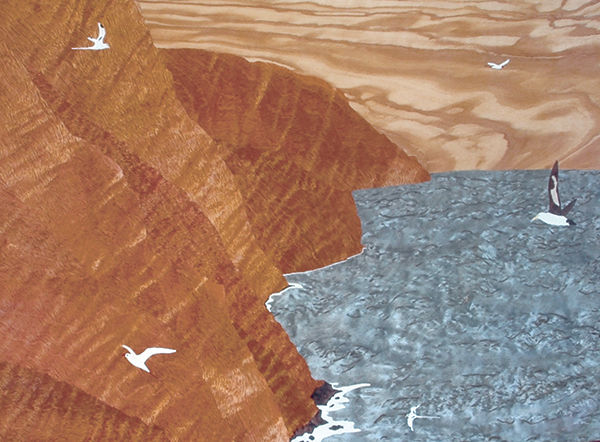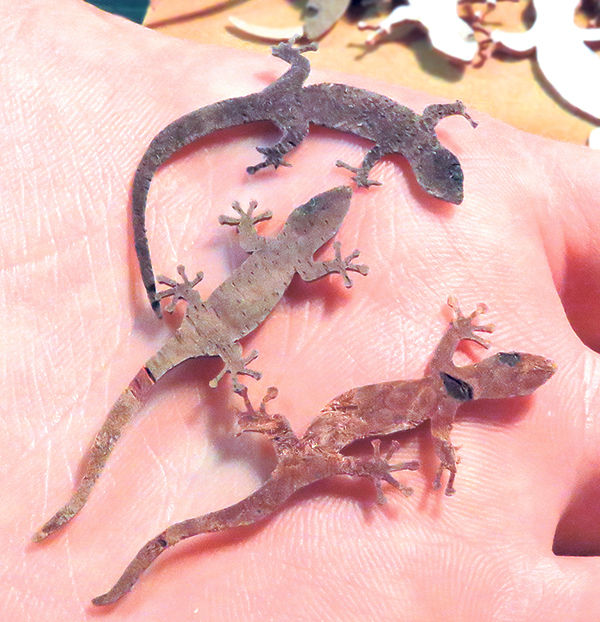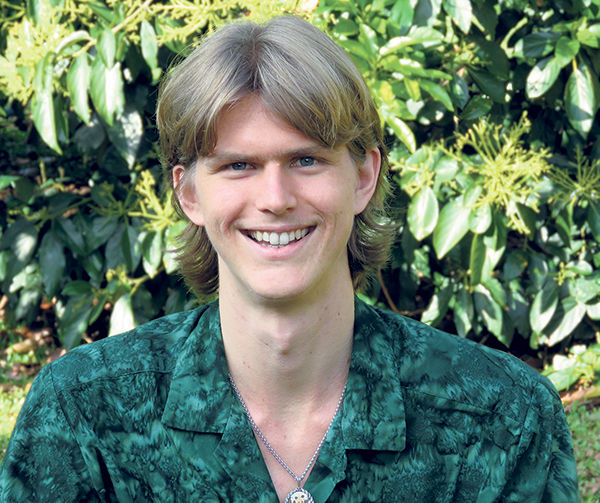Tor Chantara’s fine art of marquetry
At the age of 26, Tor Chantara lives his life simultaneously in two worlds, practicing the fine woodworking art of marquetry that has its roots in the 16th century, while learning techniques and ordering supplies via the Internet.
Marquetry, the way Tor has been doing it since he was 17 years old, requires a degree of patience and attention to detail that was more common centuries ago, in order to achieve a certain level of artistry. A thoughtful young man, Tor even expresses himself in somewhat of an Old World way, punctuating his remarks with “certainly” and “indeed.”
The marquetry veneers that Tor uses for his work are pieces of wood only 1/42 of an inch thick. To wrap your mind around that figure, envision the marks on a ruler that signify 1/16 of an inch. Tor’s veneers are 1/3 of that — roughly the thinness of a standard postcard.
He designs scenes that mimic those found in nature, especially those on Kauai’s North Shore where he lives: graceful seabirds flying over the ocean or along the cliffs of the Na Pali Coast, nesting albatross, sea turtles and dolphins.
He prefers to use “figured” woods, those whose grains and burls look like elements found in nature. For example, Karelian birch makes a strikingly realistic ocean, its natural characteristics evoking the varying depths and currents found on Kauai’s rugged northern coastline. Mediterranean olive is his favorite for skies; mahogany or koa for mountains. Holly creates the white foam where the ocean splashes against the cliffs.
He cuts each element or shape by hand, using a blade as thin as a sewing needle.
“I’ve always been able to focus with good attention to detail,” he says, in the understatement of the month.
“It can be a bit challenging to keep things together as the design elements get smaller,” Tor says. “When I am cutting with the grain, things hold together quite readily, but cross-grain, they become vastly more delicate, much more quickly.
“Mostly I do pretty well, but there are times when gecko toes fall off. I have to stuff them in place,” he says, smiling.
The field of marquetry isn’t crowded.
“It was only about a year and half ago that I even met anyone who does marquetry professionally,” he says. “There are marqueteurs scattered throughout the world, but it’s not particularly common.”
‘Started teaching myself’
Tor has always had an affinity for tools and woodworking, maybe in part because his father, Neal, is a third-generation builder.
“When I was little, my favorite toys were tools, a tape measure, a hammer and nails,” Tor says. “When we lived in Maine, I must’ve been 4 years old, I had a post in the house and a box of nails and hammer. I put quite a lot of nails into that post.”
Neal says hammering nails wasn’t Tor’s only gift as a young boy.
“He used to take everything apart that he could get his hands on. He wanted to see how things were made,” Neal says.
It was several years before Tor learned how to put things back together again.
When Tor was 17 and the family was building their own home in Kilauea, he got his first taste of the specific type of woodworking that would become his career.
The family decided to create a curved countertop in their kitchen. Tor, who had been given a scroll saw as a Christmas present the year before, did the actual work. The countertop is filled with beautiful wooden inlays of sea turtles, seabirds, dolphins and nautilus shells that he created.
His passion was ignited.
“I was looking at possibly doing more of that kind of work, so I started researching online and learned about using veneers. I bought some veneers and got the books the Hawaii library system had on marquetry, and started teaching myself,” he says.
“I started with a few patterns in the books I’d gotten, then once I’d done a few and gotten a little bit used to working with veneers, I started printing my own photographs and making patterns from those,” he says. He pulled from his library of island wildlife and scenic photos he had taken when he had been considering becoming a professional photographer.
When it was time to learn how to finish and protect his art pieces, he again turned to the Internet. He discovered French polish, a technique from the 1700s. He taught himself by reading books, online articles and participating in a woodworkers’ forum. Then he practiced until he had perfected the skill.
“A French polish is often regarded as one of the most beautiful finishes ever invented for furniture and fine woodwork, and I’m certainly inclined to agree with that. That’s one of the reasons I chose it,” he says.
“Another reason is that it’s one of the easiest finishes for a future restorer to repair,” he says. “As much as I can, I try to work with techniques that would be appropriate for use in museum restoration so that my work can last for centuries.”
Tor credits much of his success to the time his parents allowed him to follow his passion, by “unschooling” him, a technique of allowing children’s learning to be directed by their own interests, rather than by a set curriculum.
“We tried two private schools for about a year when we came to the island; neither one worked,” Tor says. When he was 10 years old, his mother learned about “unschooling,” and gave it a try.
“Unschooling” has proven to be an extraordinary blessing for the Chantara family. At 23, Tor’s younger sister, Chanterelle, runs her own fashion design business and is also an accomplished pianist with a growing number of students. His younger brother, Beorn, 19, a violinist, won a scholarship to the Berklee College of Music’s summer program two years ago. All three children are extremely well-spoken, motivated to spend many hours at their individual crafts, and extremely happy to be pursuing what they love.
Would Tor have discovered marquetry if he had attended a regular school?
“I wouldn’t have had the time available to find it. School just takes up so much time, there isn’t time to look for other options,” Tor says. “Having the time to explore lots of possibilities certainly increases the chance of finding something you’re passionate about, and allows the ability to explore options in more depth, as well.”
‘Marquetry happens here’
Tor motions inside his small workshop that is connected by a catwalk to his family’s home.
“Marquetry happens here,” he says.
Stacks of wood veneers of varying lengths and widths await his creative inspiration. A box of carved geckos made of a handful of different types of wood sits on a shelf, left over from prior projects. Each gecko foot is complete with five delicate rounded toes.
“It’s very hard to keep track of how much time goes into one wooden box or one image, because I cut one piece, then I glue it in place, then it has to sit for awhile and dry before I can go onto the next piece, generally the next day,” he says.
When he is “sand shading,” using heated sand to change the color of selected spots of wood, it can take even longer. “It’s a lot of small chunks of time over weeks to months,” he says. “I always have quite a few projects going at once.”
He recently made a lovely prototype marquetry pendant of a panda bear and is considering making more similar jewelry items. He also has been mulling some furniture designs.
Tor’s work can be seen at Martin & MacArthur fine art stores on Kauai at Kukuiula Shopping Center in Poipu, on Oahu and on the store’s website. He is also frequently a featured artist at Martin & MacArthur during Art Walk on the second Saturday evening of each month at Kukuiula Shopping Center. The first piece he ever sold at a Martin & MacArthur store was purchased by a Japanese museum owner.
In his free time, Tor plays viola in the Kauai Community College orchestra, has played violin and accordion in the past, and also has sung in four different island choirs. He also dabbles in computer programming, enjoys water gardening, hiking, biking and reading.
For now, he is very pleased to be doing marquetry full-time.
“I’m exploring various possibilities for what I can do and what other directions I can take,” he says. “I’ve got lots of ideas to keep exploring.”
•••
Pamela Varma Brown is the publisher of the book, “Kauai Stories,” and the forthcoming “Kauai Stories 2.”




